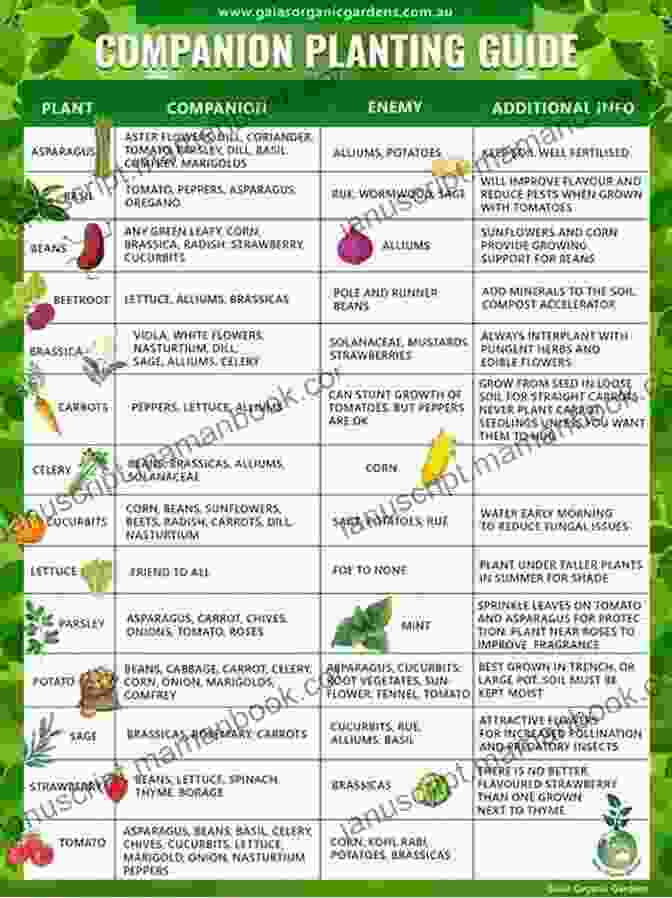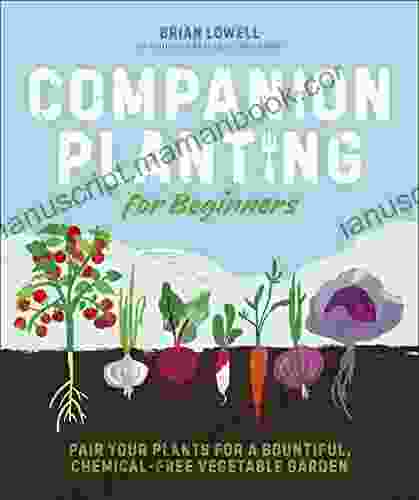Companion Planting For Beginners: A Comprehensive Guide to Maximizing Your Garden's Health and Productivity

Companion planting, the practice of growing compatible plants together to enhance their growth and yield, has been used by gardeners for centuries. By carefully selecting companion plants, you can create a thriving garden ecosystem that benefits both your plants and the environment. This comprehensive guide will provide beginners with everything they need to know about companion planting, from understanding the principles to selecting the best companion plants for their needs.
Understanding the Principles of Companion Planting
Companion planting is based on the principle of allelopathy, the chemical interactions between plants. Some plants release compounds that benefit neighboring plants (allelopathic),while others release compounds that inhibit their growth (autotoxic). By understanding these interactions, you can strategically place plants in your garden to maximize their mutual benefits.
4.9 out of 5
| Language | : | English |
| File size | : | 179751 KB |
| Text-to-Speech | : | Enabled |
| Screen Reader | : | Supported |
| Enhanced typesetting | : | Enabled |
| Print length | : | 440 pages |
There are three main types of companion planting relationships:
- Beneficial: These relationships occur when one plant provides benefits to another, such as improving growth, pest resistance, or soil health.
- Neutral: These relationships have no significant impact on each other, allowing them to coexist peacefully in the same space.
- Detrimental: These relationships occur when one plant inhibits the growth or health of another, often through the release of allelopathic compounds.
Selecting Compatible Companion Plants
Choosing the right companion plants is crucial for maximizing the benefits of this technique. Consider the following factors when selecting plants:
- Plant Family: Plants from the same family often have similar nutrient requirements and growth habits, making them good companions.
- Soil pH Preference: Ensure that companion plants have similar pH preferences to avoid soil compatibility issues.
- Light Requirements: Consider the light requirements of each plant and place them accordingly to avoid shading or competition.
- Growth Patterns: Choose companion plants with different growth patterns to optimize space utilization and prevent overcrowding.
Specific Companion Planting Combinations for Beginners
Here are some proven companion planting combinations to get you started:
- Tomatoes and Basil: Basil repels tomato hornworms, while tomatoes provide shade for basil, protecting it from scorching.
- Carrots and Onions: Onions repel carrot flies, while carrots loosen the soil, making it easier for onions to grow.
- Corn and Beans: Corn provides support for climbing beans, while beans fix nitrogen in the soil, benefiting both plants.
- Cucumbers and Nasturtiums: Nasturtiums attract aphids, which feed on their leaves instead of cucumber leaves.
- Roses and Garlic: Garlic repels aphids and black spot, common pests and diseases of roses.
Planning Your Companion Garden
When designing your companion garden, keep the following tips in mind:
- Use a Companion Planting Chart: Refer to a companion planting chart to quickly identify compatible and incompatible plant combinations.
- Consider the Garden Layout: Plan your garden to maximize the benefits of companion planting by grouping compatible plants together.
- Rotate Crops: Practice crop rotation to prevent soil depletion and disease buildup, which can disrupt companion planting relationships.
Benefits of Companion Planting
Incorporating companion planting into your gardening practices offers numerous benefits:
- Increased Crop Yield: Compatible companion plants can enhance each other's growth and productivity.
- Reduced Pest Pressure: Some companion plants act as natural repellents, deterring pests from your garden.
- Improved Soil Health: Nitrogen-fixing companion plants enrich the soil, benefiting neighboring plants.
- Weed Suppression: Ground cover companion plants can suppress weeds, reducing maintenance and competition.
- Biodiversity: Companion planting attracts a variety of beneficial insects and pollinators, enhancing the overall garden ecosystem.
Companion planting is a valuable technique that can elevate your gardening experience. By understanding the principles, selecting compatible plants, and planning your garden effectively, you can create a thriving and productive garden. Whether you're an experienced gardener or just starting out, incorporating companion planting into your practice will reap numerous benefits for your plants, your garden, and the environment. Happy gardening!

4.9 out of 5
| Language | : | English |
| File size | : | 179751 KB |
| Text-to-Speech | : | Enabled |
| Screen Reader | : | Supported |
| Enhanced typesetting | : | Enabled |
| Print length | : | 440 pages |
Do you want to contribute by writing guest posts on this blog?
Please contact us and send us a resume of previous articles that you have written.
 Top Book
Top Book Novel
Novel Fiction
Fiction Nonfiction
Nonfiction Literature
Literature Paperback
Paperback Hardcover
Hardcover E-book
E-book Audiobook
Audiobook Bestseller
Bestseller Classic
Classic Mystery
Mystery Thriller
Thriller Romance
Romance Fantasy
Fantasy Science Fiction
Science Fiction Biography
Biography Memoir
Memoir Autobiography
Autobiography Poetry
Poetry Drama
Drama Historical Fiction
Historical Fiction Self-help
Self-help Young Adult
Young Adult Childrens Books
Childrens Books Graphic Novel
Graphic Novel Anthology
Anthology Series
Series Encyclopedia
Encyclopedia Reference
Reference Guidebook
Guidebook Textbook
Textbook Workbook
Workbook Journal
Journal Diary
Diary Manuscript
Manuscript Folio
Folio Pulp Fiction
Pulp Fiction Short Stories
Short Stories Fairy Tales
Fairy Tales Fables
Fables Mythology
Mythology Philosophy
Philosophy Religion
Religion Spirituality
Spirituality Essays
Essays Critique
Critique Commentary
Commentary Glossary
Glossary Bibliography
Bibliography Index
Index Table of Contents
Table of Contents Preface
Preface Introduction
Introduction Foreword
Foreword Afterword
Afterword Appendices
Appendices Annotations
Annotations Footnotes
Footnotes Epilogue
Epilogue Prologue
Prologue Shawn Wickens
Shawn Wickens Denis Shapiro
Denis Shapiro Luis Chesney Lawrence
Luis Chesney Lawrence Etienne Toussaint
Etienne Toussaint Mark Stone
Mark Stone Dan Ariely
Dan Ariely Ron Simplified Myers
Ron Simplified Myers Alan Lowe
Alan Lowe L J Trafford
L J Trafford Shmuel Breban
Shmuel Breban Jennifer Yamin Ali
Jennifer Yamin Ali Alan Jackson
Alan Jackson Masashi Kishimoto
Masashi Kishimoto Tripp Mickle
Tripp Mickle Daniel Martins De Barros
Daniel Martins De Barros William A Graham
William A Graham Richard Grant
Richard Grant Erin Garcia
Erin Garcia Edward Bellamy
Edward Bellamy Alan Taylor
Alan Taylor
Light bulbAdvertise smarter! Our strategic ad space ensures maximum exposure. Reserve your spot today!

 Aldous HuxleyFame: The Cast of Glee - A Journey Through Triumph, Tragedy, and the Power of...
Aldous HuxleyFame: The Cast of Glee - A Journey Through Triumph, Tragedy, and the Power of...
 Dwight BlairUnveiling the Concealed Powers Guiding Our Choices: The Hidden Forces Shaping...
Dwight BlairUnveiling the Concealed Powers Guiding Our Choices: The Hidden Forces Shaping... Nathan ReedFollow ·18.9k
Nathan ReedFollow ·18.9k Forrest BlairFollow ·14.8k
Forrest BlairFollow ·14.8k Ira CoxFollow ·3.1k
Ira CoxFollow ·3.1k Aleksandr PushkinFollow ·4.4k
Aleksandr PushkinFollow ·4.4k Jeremy CookFollow ·18.6k
Jeremy CookFollow ·18.6k Terence NelsonFollow ·14.8k
Terence NelsonFollow ·14.8k Corbin PowellFollow ·2.8k
Corbin PowellFollow ·2.8k Leslie CarterFollow ·9.8k
Leslie CarterFollow ·9.8k

 Jaylen Mitchell
Jaylen MitchellPretime Piano Jazz Blues Primer Level: A Comprehensive...
The Pretime Piano...

 Mark Twain
Mark TwainSurviving and Thriving with the Self-Absorbed: A...
Interacting with self-absorbed...

 John Keats
John KeatsTo Love Is To Surrender: A Deep Dive into the...
Surrender is one of the most enigmatic and...

 Steven Hayes
Steven HayesRich Murphy: A Visionary Engineer Shaping the Future of...
In the annals of space...

 Neil Parker
Neil ParkerProper Love: Navigating the Hardships of the Heart
Love is a beautiful emotion that can bring...
4.9 out of 5
| Language | : | English |
| File size | : | 179751 KB |
| Text-to-Speech | : | Enabled |
| Screen Reader | : | Supported |
| Enhanced typesetting | : | Enabled |
| Print length | : | 440 pages |










